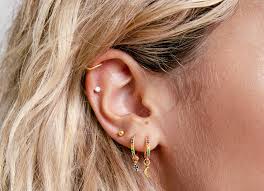
Ear piercing is one of the most popular forms of body modification and self-expression around the world. It has a rich history, diverse cultural significance, and various health considerations. Whether you’re considering getting your ears pierced for the first time or are already an aficionado of body jewelry, this guide will provide you with essential information about ear piercing.
Ear piercing dates back thousands of years, with the earliest evidence found in ancient civilizations such as Egypt and Mesopotamia. Archaeologists have discovered mummies with pierced ears, suggesting that this practice was culturally significant. In many cultures, ear piercings are associated with rites of passage, status, or spiritual significance.
In modern times, ear piercing has evolved into a widespread trend detached from its historical roots. It has become a fashion statement and a form of personal expression, transcending age, gender, and cultural boundaries.
There are several types of ear piercings, each with its unique position and purpose. Here are some of the most common styles:
Lobe Piercing: The most popular and traditional type of ear piercing, lobe piercings go through the fleshy lower part of the ear. They can accommodate various types of earrings, from studs to large hoops.
Cartilage Piercing: This involves piercing the harder, upper part of the ear. Cartilage piercings can be found in many locations, including the helix (outer rim), the tragus (small flap at the front of the ear canal), and the conch (the inner shell of the ear).
Industrial Piercing: An industrial piercing is characterized by two holes connected by a single piece of jewelry, often a barbell. It typically goes through the upper cartilage of the ear.
Daith Piercing: This is a type of cartilage piercing located in the innermost fold of the ear. Some believe that it can help relieve migraines, although scientific evidence is limited.
Rook Piercing: This involves piercing the cartilage in the fold above the tragus and is often adorned with hoops or small studs.
There are two primary methods for ear piercing: using a needle or a piercing gun. Each method has its advantages and considerations:
Needle Piercing: Considered the safer and more precise method, needle piercings involve a hollow needle that cleanly removes a section of tissue. This method typically results in less trauma to the surrounding area, promoting better healing and reducing the risk of complications.
Piercing Gun: Though commonly used in mall settings, piercing guns can cause more tissue damage and are often associated with a higher risk of complications like infections or keloids. Notably, they are generally not recommended for cartilage piercings.
Proper aftercare following an ear piercing is crucial for healing and preventing infections. Here are some general guidelines to follow:
Keep it Clean: Clean the area around the piercing with saline solution or a wound cleaner recommended by your piercer. Avoid using alcohol or hydrogen peroxide, which can irritate the skin.
Avoid Touching: Resist the urge to touch or twist the jewelry. Clean hands should be used when handling the area, and it's best to avoid unnecessary contact.
Don’t Change the Jewelry Prematurely: Allow the piercing to fully heal before switching out jewelry. This often takes 6-12 weeks for lobe piercings and longer for cartilage piercings.
Wear Appropriate Shoes: If you choose to sleep on your side, consider using a travel pillow to avoid pressure on the new piercing.
Monitor for Signs of Infection: Keep an eye out for excessive redness, swelling, or discharge, which could indicate an infection. Seek prompt medical advice if you notice any of these symptoms.
Ear piercing carries different meanings in various cultures. In some societies, it is a rite of passage, marking a transition from childhood to adulthood. In others, it symbolizes beauty, femininity, or social standing. For example, among some Indigenous peoples, ear piercing is an important ceremonial practice. Understanding the cultural significance behind ear piercing can inspire deeper appreciation for this self-expressive art form.
Ear piercing is more than just a trend; it is a practice steeped in history and cultural significance. Whether you view it as a rite of passage, a fashion statement, or a form of self-expression, taking the proper precautions and understanding the types of ear piercings available will ensure a safe and fulfilling experience. Always consult with a professional piercer and prioritize aftercare to fully enjoy your new adornments.
If you would like to take advantage of my ear piercing service please call Claire Watts on 07903517415.